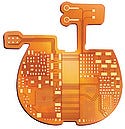Implantable Neurostimulators Generate Opportunities, Challenges for OEMs
April 8, 2009
Click to enlarge |
Providing flexibility, high voltage, and low power consumption, semiconductors from ON Semiconductor can be integrated into neurostimulators. |
When his parachute failed to deploy while skydiving on leave in 2006, 26-year-old Army parachutist Adam Hammond made contact with the ground at a velocity of more than 45 mph. Although lucky to be alive, Hammond suffered extensive injuries that included a shattered pelvis, a broken femur, and a severed spine that became the source of chronic pain even after multiple surgeries and active rehabilitation efforts. Then, in September 2008, Hammond became the first patient implanted with the St. Jude Medical (St. Paul, MN; www.sjm.com) Eon Mini, touted as the smallest, longest-lasting neurostimulation device on the market for the treatment of chronic pain. Following implantation, Hammond has reported a significant reduction in pain and vast improvement in his rehabilitation, which has resulted in what he says is a dramatically improved quality of life.
And he's not the only one singing the praises of neurostimulators. Implantable neurostimulators are increasingly being used to improve the quality of life for a plethora of patients coping with conditions that run the gamut from chronic pain to epilepsy to tinnitus. But while they can suppress pain in patients, neurostimulators are the source of many headaches for engineers. Designing and developing these nascent neurological devices entails a struggle to integrate flexibility, keep a low profile, and minimize power consumption--all while keeping costs down.
Stimulating New Opportunities
Because of a surge in successful treatments in instances such as Hammond's, the world market for neurostimulation devices is forecast to reach $5.2 billion by 2012, according to a report by market research publisher Global Industry Analysts. Much of this market is localized in the United States, which the report states represents the largest market for the devices with a more than 75% share in 2008. Driving this growth in the neurostimulation sector is a demand for a better quality of life from patients coupled with increased awareness of the treatment by both doctors and patients alike.
Contributing most significantly to the skyrocketing popularity of implantable neurostimulators, however, is the generally positive feedback from patients. Neurostimulators are typically only implanted in patients for whom surgery and drug therapies have proven ineffective and whose quality of life is compromised by a neurological disorder. Once implanted, the neurostimulator acts as a sort of pacemaker for the nervous system by emitting tiny electrical impulses that block or impede certain messages to the brain. Implantable pulse generators (IPGs) are designed to suppress tremors and seizures associated with certain movement disorders, reduce instances of incontinence, and improve a host of additional neurological conditions.
Planning for the Unknown
Click to enlarge |
Minnetronix provided electronics expertise in designing for low power consumption for the Andara oscillating field stimulator. |
Backed by these primarily positive results and seemingly endless possibilities, neurostimulators offer pioneering treatment of many neurological disorders that lack a known cure. So of course, there's a catch: "Neurostim treatment on the therapy side is not that exact a science," notes Robert Tong, vice president, medical products, for semiconductor manufacturer ON Semiconductor (Phoenix; www.onsemi.com). "[OEMs know] it works, but they don't know why it works. So, there is a lot of experimentation and tuning that is required."
Experimentation in terms of therapy delivery is especially prevalent in deep brain stimulation. A treatment intended to suppress the tremors associated with Parkinson's disease and essential tremor, the procedure entails surgeons inserting leads into the targeted area of the brain through a hole in the skull. An extension connects the leads to the IPG, which is positioned under the skin, usually near the collarbone.
Prior to implantation, however, a patient typically undergoes a trial so that the doctor can evaluate his or her response to and level of pain relief by the neurostimulator. "It is common that the development of a neurostim IPG begin with the development and testing of an external pulse generator to confirm feasibility and safety," explains Dirk Smith, vice president of business development for Minnetronix Inc. (St. Paul, MN; www.minnetronix.com), which specializes in the design, engineering, and manufacture of electronics for implantable devices. Modification of the currents, frequencies, and voltages delivered by the device are necessary in order to optimize treatment for the individual patient, Tong adds.
Because of the uncertainty surrounding how the therapy should ultimately be delivered, semiconductor chip flexibility is essential to the success of the end device, Tong says. He advises neurostimulator OEMs to partner with companies that can assist in designing chips capable of adapting to varying therapy needs. ON Semiconductor, for example, custom manufactures chips for OEMs based on their specific requirements or can aid in their complete design and manufacture. But regardless of the approach, the company emphasizes the importance of employing flexible programming technology to avoid costly and time-consuming redesigns. The company also stresses the importance of designing chips that can still be modified either by external programming or by downloading different software after integration into the end device.
"If everything is built hot-wired with a fixed algorithm and a fixed approach, that would limit their flexibility to alter that particular device for different therapy applications, should the primary therapy they were looking for be unsuccessful," Tong says. "The more flexibility a chip has in terms of being able to change this therapy delivery and help with underlying therapy, the better off the device manufacturer would be in terms of protecting the investment."
Miniaturizing Size, Maximizing Life
Sidebar: Lead-ing the Way to Better Implants |
It's no wonder many of the neurostimulator market's heavy hitters also dominate the cardiac device market. Cribbing from implantable cardiac device design is, after all, at the heart of neurostimulator development. As electronic implants, the two share several distinct challenges with which implantable device manufacturers and their suppliers must contend--most notably power consumption and size.
"The cardiac rhythm management (CRM) field has continually and effectively driven the reduction of size and power consumption of implantable devices," observes Smith. "Since the form and fit of neurostimulation devices are similar to CRM devices, [OEMs] are leveraging CRM technology and design approaches to follow suit." Likewise, Minnetronix has similarly leveraged its experience with CRM devices to serve neurostimulation device manufacturers. Equipped with extensive cardiac implant know-how, the company transferred its skill set to design a neurostimulator for low power consumption, among other attributes, for the Andara oscillating field stimulator, manufactured by Cyberkinetics, for example.
Although low power consumption is a concern for cardiac implants, it is a much more pressing issue for neurostimulators. "Traditional implantable devices such as pacemakers and defibrillators don't use as much power and tend to have very low voltage. And defibrillations, even though they [require] fairly high-voltage stimulation, tend to happen very very infrequently," explains Tong. "In fact, you don't want to be shocking the patient very often [for defibrillators], whereas with neurostim devices, you tend to be stimulating the nerve on a fairly regular basis."
Click to enlarge |
Minco's high-density interconnect rigid-flex allows designers to fold circuits in a 3-D configuration to take advantage of the vertical space within an implantable pulse generator. |
Neurostimulators need to produce impulses that are not only frequent if necessary, but that are also powerful enough to override the pain impulses being sent to the brain. Tong adds that ON Semiconductor's processing technology--drawn from experience in both implantable cardiac devices and the automotive industry--enables both ultra-low-power consumption and the emission of high voltages in neurostimulators.
Another issue is that frequent deployment of strong impulses depletes implantable neurostimulators' batteries much faster than their cardiac counterparts. And when it comes to nearing the end of an implantable device battery's life, surgical explantation and replacement of the device is the patient-unfriendly route typically taken. For patients with neurostimulators, this could translate into the need for device replacement every few years. Essentially, when it comes to batteries, a drain on the power supply equates to a drain on patients.
To minimize these excess costs and procedures, neurostimulator manufacturers are on the lookout for power-providing solutions. "When the neurostim market was in its early stages, size and power, while important, were not as critical as showing efficacy of the wide range of neurostim therapies being developed," Smith notes. "As the field has matured, size and power consumption, which are tightly coupled, are receiving more attention and developers are turning to state-of-the-art battery technologies and custom integrated circuit (ASIC)-based electronics."
Piquing interest as a potential solution are rechargeable batteries, which have already made their way into some neurostimulators. Enabling this helpful function are such products as inductive coils, manufactured by Minco (Minneapolis; www.minco.com). Flex-Coils facilitate recharging and communications telemetry, and are less vulnerable to breakage than discrete coils, according to the company. "[Flex-Coils] minimize the amount of space that must be allocated to battery and extend the device life to about 10 years before replacement surgery is required," says Merle Tingelstad, Minco market analyst. "Without this recharge capability, the higher-power devices used in pain management would require larger size and surgery to replace batteries in 2-5 years."
As Tingelstad points out, battery size and power consumption are closely tied to the overall profile of the device, which is yet another design concern. Rechargeable batteries help to reduce overall package size--a definite advantage for patients in terms of comfort and cosmetics of the implant, according to Tingelstad. "Approved devices on the market today weigh only 1 oz and are 10-mm thick with the recharge feature," he adds.
Helping to further minimize the size of the impulse pulse generator and maximize internal real estate are Minco's high-density interconnect flexible circuits. The components promote design flexibility through their ability to be folded in 3-D configurations, which allows for placement of the circuits in vertical space within the implant. Multilayer flexible circuits enable miniaturization of the implant's motherboards, and rigid-flex circuits allow engineers to combine mother and daughter circuits with electromechanical devices without connectors. Eliminating connectors in this capacity not only frees up space inside the neurostimulator, but also can cut costs as well.
The Road Ahead
Although they have exhibited vast potential to treat some debilitating neurological disorders, neurostimulators are still ensconced in uncertainties. Though substantial progress has been made in a considerably short amount of time, design and development of these implants still has ample room for improvement. Areas include planning for variables in therapy delivery for individual patients, achieving the smallest profile possible, and engineering for minimal power consumption. And if these challenges weren't enough, neurostimulator manufacturers also face the daunting task of laboring over the improvement of a device for which quantifiable results are hard to come by.
"One of the challenges specific to pain management therapies is the relative subjectivity of both symptoms and the effectiveness of treatment," Smith says. Tingelstad agrees, adding, "The success rate of pain management is somewhere between 50 and 80%. It is hard to quantify because the level of pain reduction is subjective. Some people report high levels of relief, while others report the pain is tolerable with or without the addition of some amount of drug therapy. Some 20-30% find the devices to not help or claim to make things worse."
Despite the many factors sometimes impeding implantable neurostimulator improvement, manufacturers are on the right track to enhancing patient care. Not only are neurostimulators producing results in such patients as former parachutist Adam Hammond, they're also generating new outlooks on life.
Copyright ©2009 Medical Product Manufacturing News
You May Also Like





